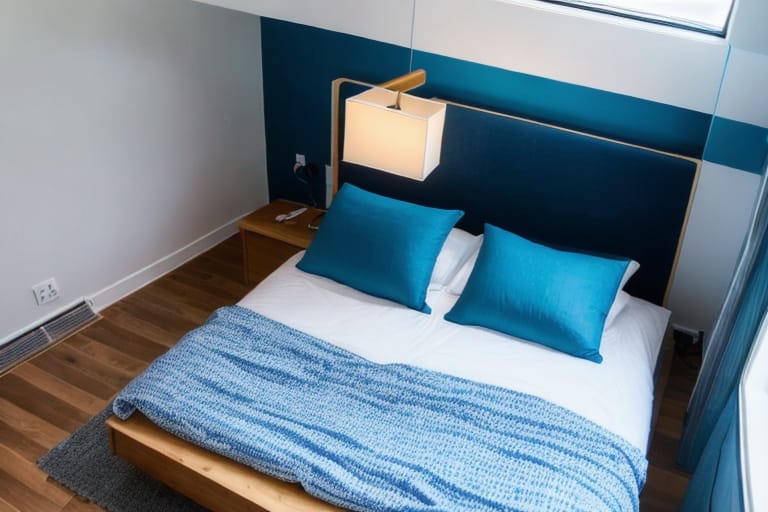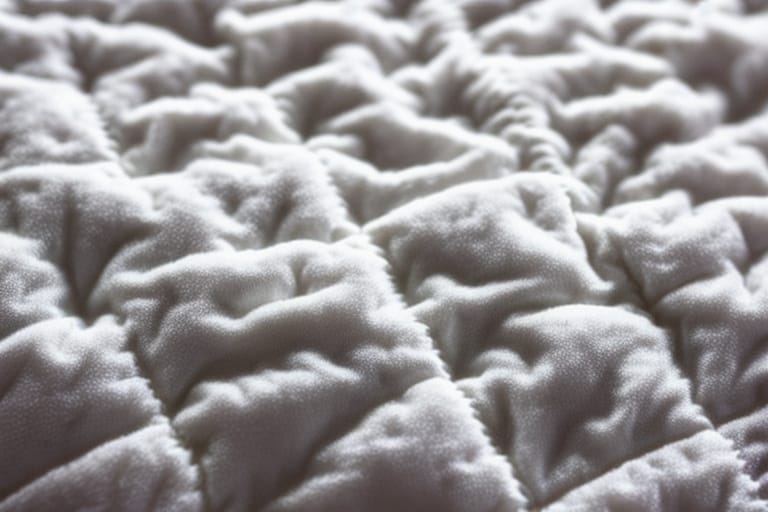Looking for a comfortable, affordable, and ethically-sourced comforter? Then down alternative comforters are an excellent choice to consider.
Down alternative comforters provide warmth and softness similar to traditional down, but without using any animal products. They are typically made from hypoallergenic synthetic fills like microfiber or PrimaLoft. Many options use recycled materials as well.
In this in-depth beginner’s guide, you’ll learn all about the composition, benefits, and common questions around down alternative comforters. Let’s dive in!
What Are Down Alternative Comforters?
Down alternative comforters contain synthetic fills to mimic the qualities of natural down fill. Materials like polyester, nylon, and rayon are used to create synthetic fiberfill.
The polyester fibers are engineered to create soft, billowy clusters that trap air and provide plush warmth like down. But unlike feather or down fills, synthetic alternatives are cruelty-free and vegan.
The most common benefit of down alternative comforters is that they are:
- Hypoallergenic
- Affordable
- Easy to clean
- Animal cruelty-free
Keep reading to learn all about the composition, benefits, and how to shop for the best down alternative comforter for your needs.
Down Alternative Comforter Fill Materials
There are two main categories of fills used in down alternative comforters:
Synthetic Fiber Fill
This refers to polyester fibers processed to mimic down clusters. Common types include:
- Polyester fiberfill – The most affordable synthetic with decent warmth
- Microfiber fill – Light and soft microfibers that trap heat efficiently
- PrimaLoft® – Premium branded fibers with down-like loft and feel
Natural Fill Blends
Some down alternative comforters blend natural fibers like rayon, modal, or TencelTM lyocell. These are plant-based cellulose fibers offering both softness and breathability.
When combined with synthetics, natural fills create a uniquely airy and lightweight feel. They help regulate temperature for hot sleepers as well.
Both types of down alternative fills are hypoallergenic, with synthetic polyester offering the most budget-friendly option.
When blended with breathable fibers like TencelTM lyocell or modal, the comforters become ideal for those prone to night sweats. The materials wick moisture and allow greater airflow.
How Are Down Alternative Comforters Constructed?
There are two main construction techniques used:
Baffle Box Design
Baffle box comforters have stitched fabric walls inside that hold the fill in separate boxes. This prevents the fill from shifting around. It allows for even distribution and consistent warmth across the comforter.
Sewn-Through Construction
With sewn-through down alternative comforters, stitching goes from the top to the bottom layer of fabric. The fill is held in channels between the stitch lines.
This style is less common nowadays. Fill can shift more easily in sewn-through comforters compared to the baffle box design.
Many down alternative comforters also have corner tabs or loops to attach a duvet cover. This allows you to change the overall look easily.
Warmth and Temperature Regulation

When it comes to warmth, down alternative comforters fall into three categories:
Lightweight: Great for hotter months or climates. Still provides some warmth for cooler nights.
All-season: Provides year-round comfort across most temperatures. The best overall choice.
Ultra warm: Ideal for cold winter weather and frigid climates. Keeps you toasty on extra chilly nights.
Thanks to synthetic fills combined with moisture-wicking fibers, many down alternative comforters also help regulate temperature. They are suitable options for both warm and cold sleepers.
Certain luxury down alternative fills like PrimaLoft® Gold Insulation offer advanced cooling technology. The fibers are shaped and blended to allow maximum airflow and keep you comfortable in any season.
Benefits for Allergies and Sensitive Skin
One of the biggest upsides of choosing down alternative over regular down comforters is they are hypoallergenic.
For those with allergies or sensitive skin, down alternative presents no reaction risk. The synthetic polyester and other hypoallergenic fills are:
- Dust mite resistant
- Mold/mildew resistant
- Non-irritating
This makes down alternative bedding ideal for children and adults that suffer from:
- Asthma
- Allergies
- Eczema
- Skin sensitivities
Many top brands also have their products tested and certified by organizations like:
- OEKO-TEX® – Ensures products have no harmful substances
- hypoallergenic – Verifies truly non-allergic materials are used
- Standard 100 by OEKO-TEX® – Confirms no toxic chemicals were used
So you can enjoy peace of mind knowing your down alternative comforter is healthy, comfy, and harmless for those with allergies or sensitivities.
How Sustainable and Eco-Friendly Are They?
One great advantage of down alternative comforters is many use recycled materials like PET fiber from plastic bottles. This gives an eco-friendly way to reuse waste.
There are also some vegan down alternatives made from unique materials like:
- TencelTM lyocell – Sustainably sourced wood pulp
- Modal – Derived from renewable Austrian beech trees
- Eucalyptus fiber
Additionally, many leading brands have certifications confirming environmental standards during production. These include:
- Global Recycled Standard (GRS)
- Global Organic Textile Standard (GOTS)
So by purchasing a down alternative comforter, you minimize waste, reduce your carbon footprint, and support responsible manufacturing practices.
Warmth and Softness
While lacking the luxurious decadence of fine goose down, modern down alternative fills come remarkably close in both warmth and plush feel.
Thanks to innovative fiber shapes and siliconization processes, synthetic microfibers create billowy clusters that mimic the heat retention of down. Many brands blend in soft natural fibers for added cloud-like comfort.
The shell fabric also affects overall coziness. For maximum sensual softness, look for down alternative comforters with:
- High thread counts – Around 400 to 600
- Smooth sateen weave – Adds luster and shine
- Luxurious cotton shell
Coupled with a baffle-box design to prevent shifting, these comforters cradle you gently as you sleep.
Ease of Care and Durability
One practical advantage of down alternative comforters is they are super easy to clean. Almost all are machine washable for convenience.
Thanks to stain-resistant synthetic fills, the comforters also tend to stay fresh and clean much longer than feather or down bedding before needing laundering.
For best results, wash your down alternative comforter on a gentle/delicate setting using mild detergent. Tumble dry on low. This preserves the fiber clusters and extends the life of the comforter.
With proper care, a quality down alternative comforter will last over a decade, outlasting lower-end down comforters. While not heirloom-level bedding, their durability combined with affordability makes down alternative an excellent value.
Cost and Affordability Compared to Down
You can pay over $1000 or more for high-end goose down comforters from luxury brands. However quality down alternative comforters start under $50.
For the budget-conscious shopper, down alternative bedding offers substantial savings over natural down, often at a fraction of the price.
While the lowest priced comforters may use cheaper polyfills compromising comfort, spending $100-$300 gives wonderful mid-range options combining value, quality and cozy softness rivaling down.
Overall, down alternative provides perhaps the best mix of affordability and luxury feel in the comforter market. You get down-like benefits without the shocking price tag!
Style and Appearance Options
Beyond just solid white, down alternative comforters today offer much expanded décor options including:
- Rich colors like navy blue or burgundy
- Soothing earth tones
- Fun patterns and embroidery
- Reversible two-toned combinations
Thanks to readily-dyeable synthetic fills and printed fabrics, manufacturers provide a rainbow of down alternative comforters to match any bedroom style.
The look and texture of the shell fabric also affects aesthetics. Smooth sateens or cozy flannels pair beautifully with stylish duvet covers.
Understanding Fill Power, Loft and Weight

With down comforters, fill power measures the fluffiness and insulation ability of the down fill. The higher the number, the better the heat retention properties.
For down alternative comforters, a similar concept is fill weight. This specifies how much fill material is inside the comforter. More ounces of fill creates a fluffier, more insulating comforter.
Typical fill weights range from about 10 oz on budget or summer-weight comforters, up to 32+ oz for luxuriously lofty ultra-warm bedding. The Goldilocks comfort zone for most is around 20 to 24 oz.
Related to fill weight is loft – how thick and billowy the comforter is. More ounces give greater plush loft. With quality baffle-box construction, the fluffiness is fairly uniform edge to edge.
Finally, the overall weight of a down alternative comforter greatly depends on the shell fabrics used. Lightweight poly-cottons keep the total weight down versus heavier jacquard-woven covers.
Ethical and Animal Welfare Considerations
For ethical consumers concerned about animal welfare and exploitation, down alternative comforters present clear benefits.
They avoid live-plucking issues surrounding some down production. The manufacturing process also creates less environmental impact without waterfowl raising and slaughter.
Synthetic fills use less total resources like water, land and feed. And recycled PET comforters put previously wasted plastic to renewed purpose.
While perhaps not offering quite the heavenly cushioning of fine goose down, modern down alternatives provide cruelty-free warmth and comfort – easing your conscience as you sleep soundly.
Health and Safety Standards
Reputable manufacturers test finished down alternative comforters to verify safe, non-toxic materials are used.
Watch for certifications like:
OEKO-TEX® Standard 100 – Confirms no harmful substances were detected that could affect health. Products awarded this label are tested for:
- Numerous regulated and non-regulated substance classes
- Numerous health-hazardous dyestuffs
- Carcinogenic aromatic amines
- Chlorophenols
- Pesticides
- Heavy metals and much more
So when shopping, double-check for such independent testing seals to ensure your bedding meets stringent health guidelines. This gives assurance the materials and construction are fully safe and non-toxic during use.
Latest Innovations in Down Alternative Technology
While polyester has been the long-time staple of down alternative fills, manufacturers keep innovating synthetic clusters for increasing performance.
PrimaLoft® Gold Insulation
This premium down alternative uses impeccably soft microfibers shaped to maximize both compression resistance and airflow. PrimaLoft® clusters have permanent loft recovery and provide excellent temperature regulation.
The ultra-fine fibers also have a water-resistant finish to help maintain insulation capacity if they do get damp. It’s a smart evolution making synthetic fills more versatile and closer to natural down properties.
Outlast® Certified Temperature Regulating Technology
Outlast® microencapsulates phase change materials (PCMs) inside synthetic fibers. This allows the bedding to store and release excess heat as needed.
As your body gets warmer, Outlast® adapts to pull heat away before sweat forms. When you cool later, it releases warmth back as needed.
Through heat absorption and release, Outlast® technology actively regulates temperature keeping you in your ideal comfort zone as you sleep.
Market Trends Favoring Down Alternatives
Various consumer shifts bolster the popularity of down alternative comforters in recent years:
Sustainability – Buyers want ecologically-sound products using recycled/renewable materials with ethical manufacturing. This favors down alternatives.
Affordability – With rising costs straining budgets, value-priced down alternatives appeal to more shoppers.
Health – Allergy sufferers and those wanting non-toxic bedding drive demand for hypoallergenic fills.
As people become more conscious of the wider impacts of their purchases, down alternative aligns well with emerging buyer values favoring ethical products safeguarding health.
Synthetic fills also continue gaining improvements lowering the historical performance gap with luxury down. This brings down alternatives more competitive against top-tier natural bedding.
Top Down Alternative Comforter Brands
The bedding market hosts dozens quality manufacturers producing down alternative comforters spanning price tiers. A few front-runners include:
Linenspa– Budget-friendly down alternative comforters with baffle-box design and corner tabs for duvets. Offered in all-season and ultra-warm versions. Prices from $30-$60.
Utopia Bedding – Mid-range comforters earning high reviews. Known for extremely soft microfiber fill and woven jacquard covers. Queen sizes around $65-$90.
California Design Den – Premier down alternative comforters rivaling high-end down. They use reinforced baffle boxes, elasticized edges, and 400 thread count cotton sateen fabric. Prices from $100-$180.
Buffy – Specialize in eco-friendly down alternative comforters sustainably produced. Made from recycled PET bottles with 100% eucalyptus fiber fill. Prices from $170-$200.
No matter your budget, you can find quality down alternative comforters from reputable companies. Comparison shop using online consumer reviews. Focus on durability, softness, and whether their warmth suits your seasonal needs.
Key Factors When Buying a Down Alternative Comforter
With an abundance of options on the market, keep these factors in mind when selecting a down alternative comforter best meeting your personal preferences:
1. Desired Warmth Level
Consider if you want lightweight, all-season, or ultra warm bedding based on your climate and sleeping tendencies. Added fill ounces boost insulation.
2. Cover Fabrics
Do you enjoy silky-smooth sateens or cozy brushed-cottons against your skin? Shell fabric affects both comfort and appearance.
3. Fill Quality
Higher denier microfibers and dense fiber clustering improve durability and billowy feel closest to natural down.
4. Special Features
Added elements like moisture-wicking fibers, elastic edging or temperature regulation create added comfort.
5. Ethical Sourcing
For sustainable shoppers, verify responsible manufacturing through certifications and brand transparency.
6. Allergies/Sensitivities
Those prone to allergies or skin irritation should confirm bedding is certified hypoallergenic and non-toxic. This ensures safety and prevents reactions.
Also note certifications like Standard 100 by OEKO-TEX® which requires strict testing of materials for the award.
7. Ease of Maintenance
Check that the comforter is machine-washable if wanting hassle-free upkeep.
By weighing each of these purchase considerations, you can select the ideal down alternative comforter tailored to your lifestyle and priorities.
Finding the Best Down Alternative Comforter – Top 7 Tips
Follow these top tips for securing a supremely cozy down alternative comforter delivering blissful sleep for years to come:
1. Set your budget – Prices range widely from $50 up to $250+ for premium quality and materials. Decide what you can invest for long-lasting comfort.
2. Pick perfect warmth – Don’t sweat or shiver! Select lightweight, medium or ultra warm insulation suited to your climate and sleep temperature.
3. Feel the fill – Compare fiber cluster density, softness and resilience. Avoid cheap clumpy polyester. Seek quality microfibers or PrimaLoft mimicking down’s billowy support.
4. Cuddle the cover – Caress potential fabric exteriors from smooth sateens to comfy cottons. This shell cradles next to your skin nightly.
5. Verify certifications – Seek seals confirming safety, non-toxic materials plus sustainable practices like Global Recycling
Frequently Asked Questions
Q: How do I know if a down alternative comforter is truly hypoallergenic?
A: Check that reputable certifications like OEKO-TEX® Standard 100 are displayed. This confirms independent testing found zero harmful substances. Also verify the materials stated are scientifically non-allergenic like polyester fibers.
Q: What’s better – PrimaLoft® or microfiber down alternative fill?
A: Both offer decent similarities to down. PrimaLoft® uses ultra-fine microfibers engineered for maximum loft, softness and compression recovery. Simple microfiber polyester costs less but lacks the airflow and support of advanced PrimaLoft® cluster fiber technology.
Q: Is down alternative warm enough for winter or cold climates?
A: Yes, “ultra warm” down alternative comforters with higher fill weights (25+ ounces) match or even exceed the insulating power of fine down. The synthetic fiber clusters effectively trap heat to keep you cozy. With a tog rating around 13+ these maintain warmth even in frigid temps.
Q: How long does a down alternative comforter last?
A: With proper care like gentle machine washing and low heat drying, a quality down alternative comforter will last over a decade thanks to durable synthetic fills. This matches if not exceeds lower-end down comforter lifespans. So you get long-term use combined with the value pricing.
Q: What thread count is best for down alternative cover fabrics?
A: Look for thread counts between 400-600 for optimal softness and durability. Lower thread counts feel scratchy from loose weaves while higher numbers don’t equate to proportional added comfort. Sateen weave also enhances soft luxury feel.
Q: Is down alternative better for people with allergies?
A: Yes, down alternative polyester and microfiber clusters are intrinsically hypoallergenic. This avoids allergic reactions some experience from natural feathers/down. Synthetics resist dust mites and mildew also bothering those sensitive to allergens. It’s the clear best choice for allergy sufferers.
Q: Are there organic or eco-friendly down alternative comforters?
A: Yes! Some exceptional down alternative comforters now use recycled PET fill material from plastics or plant-based fibers like TencelTM lyocell. Responsible brands also look for certifications like GOTS (Global Organic Textile Standard) and GRS (Global Recycled Standard) in production. These eco-friendly aspects make down alternative even more ethical.








